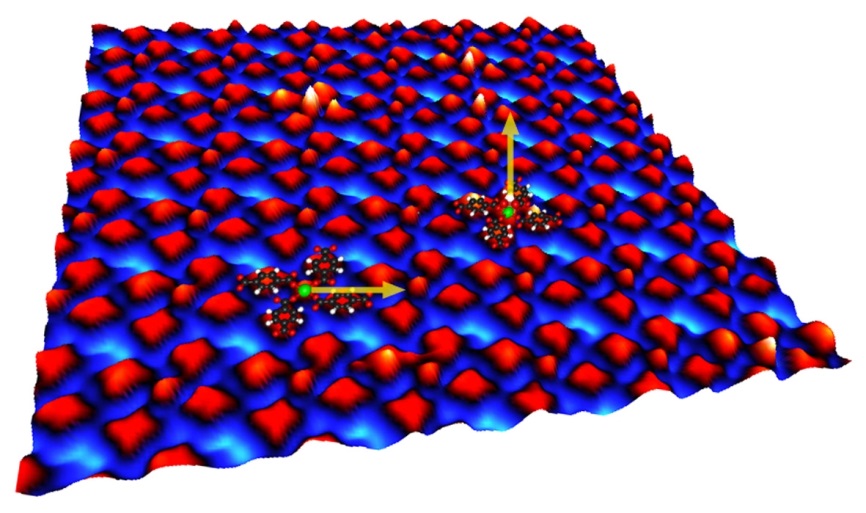Self-assembly of 2D metal-organic networks
Scanning tunneling microscope image of a two-dimensional metal-organic network self-assembled on a copper surface. Arrows indicate the preferred magnetization direction of the individual iron atoms. The magnetization direction can be manipulated by binding oxygen on the single Fe centers.
The design and fabrication of well-defined molecular architectures with atomically precise control of size, shape and composition is a topic of growing interest for a broad variety of potential applications. The self-assembly of functional organic molecules is a very attractive strategy in achieving such nanostructures, both for its efficiency as well as for the high structural quality. Our objectives are the precise engineering of functional assemblies by implementing specifically designed molecular units with tailored physical and chemical properties addressing a range of interface phenomena in nanomagnetism, i.e., magnetic coupling in organic-based two-dimensional magnets, the interplay of magnetic anisotropy and magnetic correlations with substrate electrons and spin dynamics in single-molecule or single-ion magnets. The magnetic properties are studied by both integral and local-probe methods. For the integral characterization we apply spectroscopic techniques based on synchrotron radiation by means of X-ray absorption spectroscopy (XAS) and X-ray magnetic circular dichroism (XMCD). On a local scale scanning tunneling spectroscopy (STS) and inelastic tunneling spectroscopy (IETS) at cryogenic temperatures are employed to determine the electronic and magnetic properties of isolated magnetic centers or embedded in supramolecular networks.
Selected publications:
- A molecular approach for engineering interfacial interactions in magnetic-topological insulator heterostructures, M. Cuxart, M. Valbuena, R. Robles, C. Moreno, F. Bonell, G. Sauthier, I. Imaz, H. Xu, C. Nistor, A. Barla, P. Gargiani, M. Valvidares, D. Maspoch, P. Gambardella, S. Valenzuela, A. Mugarza, ACS Nano 14, 6285 (2020). Download article (PDF, 19.1 MB)
- Superexchange-Mediated Ferromagnetic Coupling in Two-Dimensional Ni-TCNQ Networks on Metal Surfaces, N. Abdurakhmanova, T.-C. Tseng, A. Langner, C. S. Kley, V. Sessi, S. Stepanow, and K. Kern, Phys. Rev. Lett. 110, 027202 (2013). Download article (PDF, 863 KB)
- Self-assembled nanoscale magnetic networks on surfaces: fundamental interactions and functional properties, C. Carbone, S. Gardonio, P. Moras, S. Lounis, M. Heide, G. Bihlmayer, N. Atodiresei, P. H. Dederichs, S. Blügel, S. Vlaic, A. Lehnert, S. Ouazi, S. Rusponi, H. Brune, J. Honolka, A. Enders, K. Kern, S. Stepanow, C. Krull, T. Balashov, A. Mugarza, and P. Gambardella, Adv. Funct. Mater. 21, 1212 (2011). Download article (PDF, 1.4 MB)
- Orbital specific chirality and homochiral self-assembly of achiral molecules induced by charge transfer and spontaneous symmetry breaking, A. Mugarza, N. Lorente, P. Ordejon, C. Krull, S. Stepanow, M.-L. Bocquet, J. Fraxedas, G. Ceballos, and P. Gambardella, Phys. Rev. Lett. 105, 115702 (2010). Download article (PDF, 1.8 MB)
- Supramolecular control of the magnetic anisotropy in two-dimensional high-spin Fe arrays at a metal interface, P. Gambardella, S. Stepanow, A. Dmitriev, J. Honolka, F. de Groot, M. Lingenfelder, S. Sen Gupta, D.D. Sarma, P. Bencok, S. Stanescu, S. Clair, S. Pons, N. Lin, A. P. Seitsonen, H. Brune, J.V. Barth, and K. Kern, Nature Mater. 8, 189 (2009). Download article (PDF, 1.8 MB)
- Modular assembly of low-dimensional coordination architectures on metal surfaces, S. Stepanow, N. Lin, J.V. Barth, J. Physics: Condens. Matter 20, 184002 (2008).Download article (PDF, 4.3 MB)
